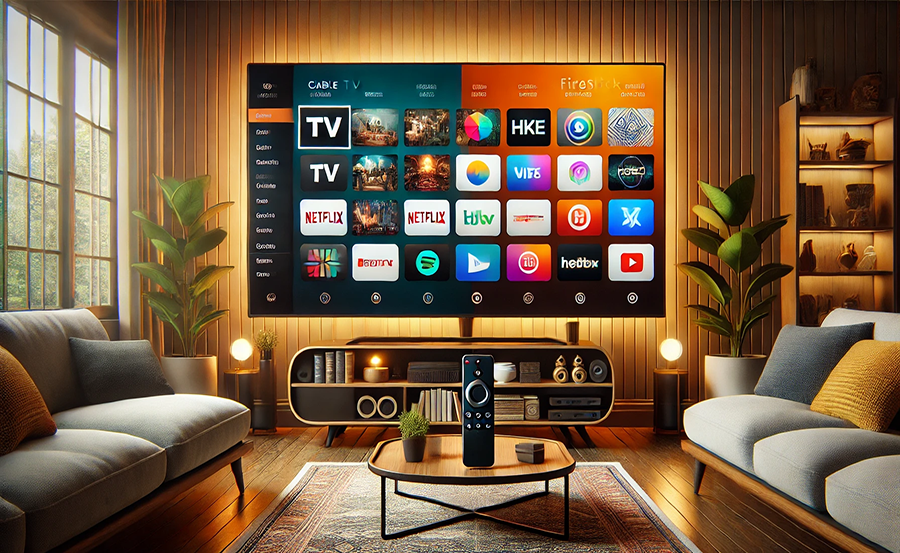For many of us, the landscape of watching our favorite shows has changed dramatically over the past decade. Gone are the days when we relied solely on cable television for our entertainment needs. Today, the options are as diverse as the people who use them. As we embark on this exploration of “Navigating the World of Streaming: From Cable TV to FireStick,” we’ll uncover how this shift is influencing our viewing habits and the ways businesses are adapting.
Buy 1 Year IPTV Subscription and Enjoy Unlimited Content
Understanding the Shift from Cable TV to Streaming
The transformation from traditional cable to streaming is not just a technological change; it’s a cultural one. Cable TV, which once dominated living rooms, is now often overshadowed by streaming devices and platforms. This shift is largely prompted by the convenience, choice, and flexibility offered by streaming services.
Streaming platforms offer the flexibility to watch what you want, when you want. Imagine being able to select a movie or series with a few clicks, without the rigid schedules and commercial breaks of cable TV. That’s precisely what streaming brings to the table.
Pro Suggestion:
Access global live TV with Calma Hub IPTV, designed for seamless streaming across all your favorite devices.
The Birth of Streaming Devices: FireStick and Beyond
In this dynamic landscape, devices like Amazon’s FireStick have played a pivotal role. They transform ordinary TVs into smart TVs, unlocking a world of entertainment options that were previously unavailable. The FireStick not only caters to conventional streaming services but also integrates with other Amazon offerings, thereby creating a seamless ecosystem for users.
Moreover, FireStick’s affordability and ease of use have made it a popular choice among consumers looking to cut the cord and embrace a more customizable experience.
Affordable IPTV: The Changing Face of Broadcast
One of the significant drivers behind this shift is the rise of affordable IPTV options. Internet Protocol Television (IPTV) is revolutionizing the way we consume media by providing cost-effective solutions compared to traditional cable packages.
Think about it: with IPTV, you have access to your preferred shows and channels without paying for the hundreds of channels that you might never watch. It’s a tailored solution for these times when consumers demand more for less.
Exploring the Best IPTV Channels for Diverse Preferences
If you’re new to IPTV, selecting the best IPTV channels to suit your preferences might seem daunting at first. The sheer variety available can be overwhelming, but it’s also what makes this technology so appealing. Let’s delve into how you can navigate this vast sea of options.
Entertainment That Fits Your Lifestyle
Consider the type of content you and your family enjoy watching. Whether it’s the latest Hollywood blockbusters, niche documentaries, or children’s programming, there’s an IPTV channel offering that caters specifically to those needs. By focusing on your lifestyle and preferences, you can maximize your viewing pleasure.
Look for IPTV services that provide high-definition streams and have a reputation for reliability. No one wants their favorite show to buffer at a crucial moment!
Discover Superior IPTV Viewing Experiences
To discover superior IPTV viewing experiences, it’s essential to do some homework. Reading reviews, understanding user feedback, and even trying out free trials can give you a first-hand feel of what different IPTV services offer. Not all IPTV services are created equal, and what works for one viewer might not work for another.
It’s also worth noting that many IPTV providers offer flexible plans that allow you to scale up or down based on your viewing habits, ensuring you’re never locked into a rigid package.
The Business Impact of the Streaming Revolution
Beyond personal choice and convenience, the shift from cable to streaming has profound implications for businesses in the entertainment industry. Content creation, distribution, and consumption are all undergoing changes due to this technological wave.
Opportunities for Content Creators
For content creators, streaming platforms represent an unparalleled opportunity to reach global audiences. Unlike traditional cable networks, streaming services often welcome a wider variety of content, giving a voice to diverse creators. This democratization of content distribution allows smaller creators to compete alongside industry giants.
Furthermore, the analytics provided by streaming platforms allow producers to tailor content more effectively to audience preferences, enhancing viewer engagement and satisfaction.
Adapting Marketing Strategies
Businesses must continuously adapt their marketing strategies to align with streaming trends. The traditional model of commercial breaks is evolving into targeted, user-specific advertisements. This shift enables advertisers to better engage potential customers through personalized content.
In essence, streaming platforms provide a new avenue for brands to reach potential consumers in ways that are far more targeted than ever before.
Overcoming Obstacles in the Streaming World
Despite its benefits, the streaming landscape is not without challenges. Users often face issues such as connectivity problems, content overload, and the paradox of choice. By understanding these challenges, users can make informed decisions to enhance their viewing experiences.
Technical Challenges and Connectivity
Connectivity remains a crucial aspect of streaming. While broadband coverage continues to improve, achieving a seamless streaming experience can be elusive, particularly in regions with inadequate infrastructure. Individuals may need to invest in higher-speed internet plans or consider wired connections to overcome such hurdles.
It’s always a good idea to conduct periodic speed tests and have backup solutions like downloading content for offline viewing to ensure your entertainment is uninterrupted.
Combating Content Overload
With a plethora of options, viewers often find themselves in a paradox of choice—too many options can lead to decision paralysis. Services such as curated playlists or recommendation engines can help streamline choices, guiding users to content that aligns with their tastes.
Setting up family profiles or utilizing watchlists are also effective methods to personalize and organize viewing options, minimizing the overwhelm and maximizing enjoyment.
Innovations to Anticipate in Streaming Technology
As the landscape continues to evolve, the future of streaming promises even more exciting innovations. Let’s glance at what you can expect as technology continues to advance at breakneck speed.
Interactive and Immersive Experiences
The future of streaming isn’t just passive viewing; it’s becoming increasingly interactive. With virtual and augmented reality technologies on the rise, viewers may soon find themselves immersed in experiences that blur the lines between watching and participating.
Such innovations could transform how stories are told and consumed, creating new avenues for audience engagement and interaction with content.
Enhanced Personalization Through AI
Artificial Intelligence (AI) is set to drive even deeper personalization in streaming services. Platforms are likely to leverage AI to analyze viewing habits and deliver tailored recommendations with more precision than ever. This could also extend to dynamic adjustments of content quality according to viewing conditions, enhancing the overall experience.
- Improved content algorithms for personalized viewing
- Adaptations in real-time quality based on bandwidth
- Voice-activated controls enhancing accessibility
FAQs: Common Questions About Streaming

1. How does IPTV differ from traditional cable TV?
IPTV uses the internet to stream television channels, offering more flexibility in terms of content selection and pricing models. Unlike cable TV, which relies on satellite or cable infrastructure, IPTV offers users the ability to customize their viewing packages to better suit individual preferences and budgets.
2. What makes FireStick a popular choice for streaming?
FireStick is favored due to its user-friendly interface, affordability, and the vast array of supported apps. It turns any TV with an HDMI port into a smart TV, allowing access to major streaming services and playing a key role in cord-cutting for many households.
3. Can I still watch live TV through streaming services?
Yes, most IPTV services and streaming platforms like Hulu Live or Sling TV offer live TV options, often replicating the live experience traditionally provided by cable TV. High-speed internet is typically required to ensure smooth live streaming.
4. Are there any significant cost savings with switching to streaming?
Many viewers find streaming services to be more cost-effective than traditional cable. They only pay for what they watch. However, subscriptions can add up, so it’s important to choose services that enhance your viewing experience without stretching your budget.
5. How do I choose the best IPTV service?
When choosing an IPTV service, consider factors such as cost, channel availability, streaming quality, and user reviews. Exploring free trials can provide insight into the service before you commit. Ensure the service meets your specific viewing needs and offers reliable customer support.
6. What challenges might I face with streaming services?
Potential challenges include connectivity issues, streaming lags, and content overload. Address these by ensuring high-speed internet access, maintaining up-to-date device firmware, and utilizing features like personalized playlists to curate viewing options effectively.
The Legality of IPTV Services: What You Need to Know





